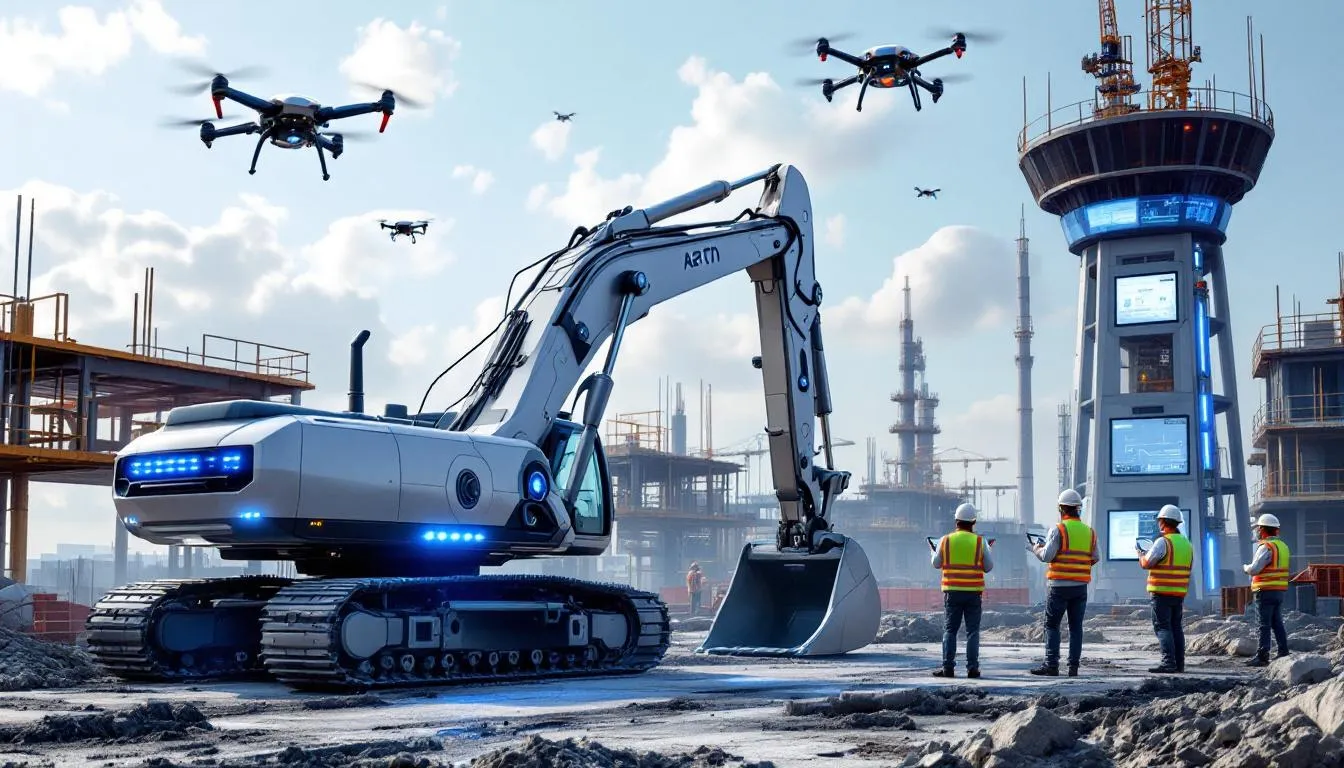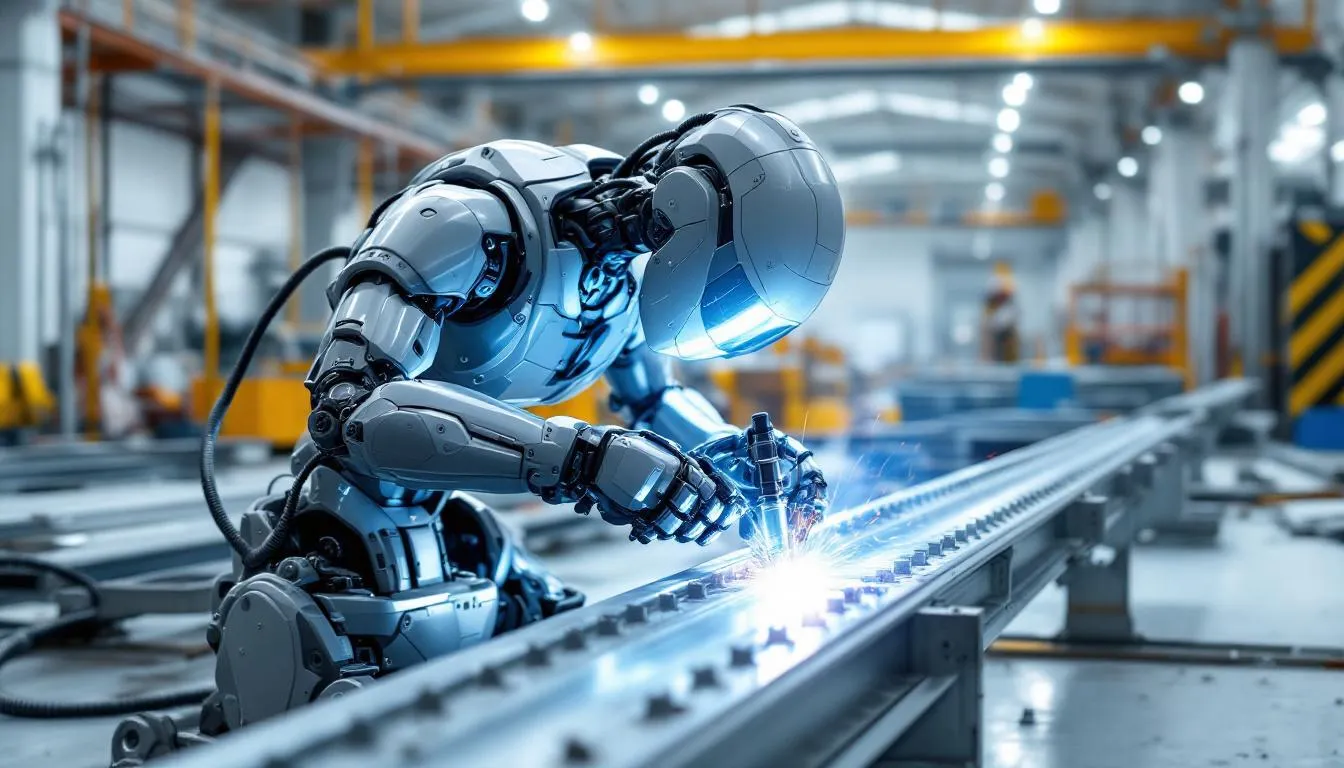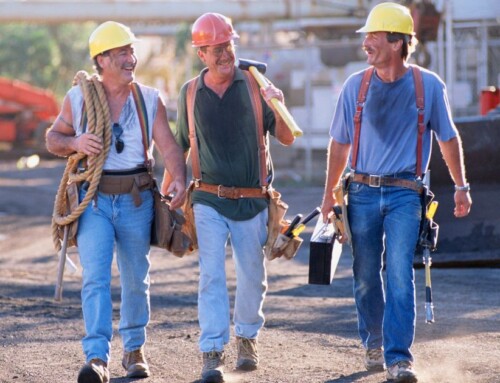The construction sector stands at a technological crossroads where artificial intelligence is reshaping how we build, manage, and deliver projects. While the industry has traditionally been slow to adopt new technologies, AI in construction industry is experiencing unprecedented growth, with market projections reaching $11.85 billion by 2029 at a compound annual growth rate of 24.31%.
This transformation extends far beyond simple digitization. Unlike Computer-Aided Design systems from the 1960s that merely digitized workflows, modern AI systems learn from data, adapt dynamically, and make complex decisions that optimize every aspect of construction projects. From reducing workplace accidents by 25% to compressing bidding cycles from weeks to minutes, artificial intelligence is becoming an essential tool for construction companies seeking competitive advantages.
What is AI in the Construction Industry?
AI in construction industry represents the integration of machine learning, computer vision, and robotics into traditional building processes. These advanced computational systems analyze massive datasets to identify patterns, predict outcomes, and automate decision-making across project lifecycles.
The technology differs fundamentally from traditional construction technology. While CAD systems digitize design workflows, AI systems continuously learn from historical data and real-time inputs to improve performance. Core components include machine learning algorithms that process project data, IoT sensors providing environmental monitoring, and autonomous machinery that operates with minimal human oversight.

Current adoption rates reflect both enthusiasm and caution within the construction sector. Recent surveys indicate 76% of architecture, engineering, and construction leaders are increasing AI investments, though 47% believe the technology may destabilize traditional industry models. This hesitation stems from legitimate concerns about workforce displacement and implementation costs, yet early adopters are already seeing measurable returns on investment.
The market trajectory supports continued growth. Grand View Research projects the global AI construction market will reach $16.96 billion by 2030, growing from $2.93 billion in 2023. This expansion is driven by increasing demand for safer work environments, pressure to reduce cost overruns, and the need for more efficient project delivery methods.
Key Benefits of AI Implementation in Construction
Enhanced Safety Through Intelligent Monitoring
AI enhances safety by providing real-time hazard detection capabilities that surpass traditional methods. Computer vision systems monitor construction sites continuously, identifying potential safety hazards such as missing protective gear, unsafe worker behavior, and dangerous equipment proximity. These systems can reduce workplace accidents by up to 25%, according to industry reports.
Predictive analytics take safety management further by analyzing historical data to identify patterns that precede incidents. Instead of reacting to accidents after they occur, AI systems enable proactive intervention by alerting supervisors to conditions that historically lead to injuries.
Improved Project Efficiency and Timeline Management
Project management benefits significantly from AI-powered tools that optimize scheduling and resource allocation. Machine learning algorithms analyze weather patterns, supply chain data, and labor availability to create more accurate project timelines. This approach reduces delays caused by unforeseen circumstances and improves overall construction productivity by approximately 20%.
Real-time progress monitoring through computer vision eliminates manual reporting delays. AI systems can analyze photo and video footage from construction sites to automatically update project status, identify deviations from planned schedules, and alert project managers to potential bottlenecks before they impact critical path activities.
Cost Reduction and Waste Minimization
Predictive maintenance represents one of the most immediate cost benefits of AI adoption. By monitoring equipment health through IoT sensors and machine learning algorithms, construction firms can prevent costly breakdowns and extend equipment lifespan. This proactive approach reduces unscheduled downtime and maintenance costs while maximizing return on equipment investments.
Material optimization through AI-driven analysis reduces waste and cost overruns. Advanced algorithms analyze project specifications, historical consumption patterns, and real-time progress to optimize material ordering and delivery schedules. This precision reduces storage costs, minimizes waste, and ensures materials arrive exactly when needed.
Core AI Technologies Revolutionizing Construction
The construction industry’s AI transformation relies on four foundational technologies that work together to create intelligent, responsive building environments.
Machine Learning and Predictive Analytics
Artificial neural networks form the backbone of construction AI systems, processing vast amounts of historical data to identify patterns invisible to human analysis. These systems excel at predictive maintenance applications, where they monitor equipment health through sensor data and predict failures before they occur.
Project timeline forecasting represents another powerful application. Machine learning algorithms incorporate weather data, supply chain factors, and labor availability to create dynamic schedules that adjust automatically to changing conditions. Cost estimation automation has reduced bidding time from weeks to minutes while improving accuracy through analysis of past projects and current market conditions.
The technology’s pattern recognition capabilities extend to supply chain management, where AI systems anticipate delivery delays, labor shortages, and material price fluctuations. This foresight enables construction teams to implement mitigation strategies before problems impact project progress.
Computer Vision and Image Recognition
Computer vision tools transform how construction sites monitor safety, quality, and progress. AI-powered cameras provide continuous surveillance, detecting when workers lack proper protective gear or engage in unsafe behaviors. This real-time monitoring capability significantly reduces response times to safety violations.
Progress tracking through drone photography and automated site inspections eliminates manual documentation requirements. Computer vision systems analyze images to measure completion percentages, identify deviations from building codes, and generate automated reports for project stakeholders.
Quality control applications use image analysis to identify structural defects and design flaws that might escape human inspection. These systems can detect concrete cracks, improper installations, and specification violations with greater consistency than traditional methods.

Internet of Things (IoT) Integration
Sensor networks create the data foundation necessary for effective AI implementation. Environmental monitoring systems track air quality, temperature, noise levels, and other factors that impact worker safety and productivity. This real-time data enables immediate response to hazardous conditions.
Wearable devices monitor worker location and safety conditions, providing alerts when personnel enter dangerous areas or when environmental conditions exceed safe thresholds. Smart equipment tracking prevents theft and optimizes utilization by providing real-time location data for tools and machinery.
The integration of IoT sensors with AI algorithms creates predictive capabilities that extend equipment life and reduce maintenance costs. Vibration sensors on construction equipment can detect bearing wear, hydraulic system problems, and other issues before they cause failures.
AI Robotics and Autonomous Systems
AI powered robots are increasingly common on construction sites, performing repetitive tasks with greater precision and consistency than human workers. Collaborative robots, or cobots, assist with bricklaying, welding, and heavy lifting while working safely alongside human crews.
Autonomous machinery including bulldozers, excavators, and pavers can operate with minimal human input, following predetermined paths and adjusting to ground conditions automatically. This automation reduces labor costs while improving safety by removing workers from potentially dangerous operations.
3D printing robots represent an emerging application where AI systems produce concrete structures and building components directly on-site. These systems can work continuously, producing complex geometries that would be difficult or impossible with traditional construction methods.
15 Practical AI Applications in Construction Projects
Project Planning and Design
Generative design tools use AI algorithms to create optimized building layouts that consider structural codes, material constraints, and performance targets simultaneously. These systems can generate hundreds of design alternatives in the time it would take human designers to create a few options.
AI-powered BIM integration automates clash detection, identifying conflicts between architectural, structural, and MEP systems before construction begins. This early detection prevents costly rework and delays during the construction process.
Energy efficiency optimization through AI-driven building performance simulations helps designers create high-performance buildings. These systems model HVAC and electrical systems performance under various conditions, optimizing energy efficiency before ground is broken.
Automated architectural drawings and 3D modeling based on project specifications reduce design time and improve accuracy. AI systems can generate construction documents that comply with local building codes and project requirements.
Project Management and Scheduling
Real-time progress tracking using computer vision analysis eliminates manual reporting delays. AI systems analyze site photos and videos to measure completion percentages and identify deviations from planned schedules automatically.
Resource allocation optimization balances labor, equipment, and materials according to project needs and availability. Machine learning algorithms consider historical productivity data, current conditions, and resource constraints to create efficient allocation plans.
Automated budget monitoring systems track expenses against projections and alert project teams to potential cost overruns before they become critical. These systems integrate with procurement systems to provide real-time cost visibility.
Weather-adjusted scheduling accounts for external factors that affect construction timelines. AI systems incorporate weather forecasts, seasonal patterns, and historical delays to create more realistic project schedules.

Safety and Risk Management
Hazard detection systems identify unsafe conditions and worker behavior in real-time. Computer vision systems can detect workers without protective gear, unsafe equipment operation, and potential structural hazards immediately as they occur.
Predictive safety analytics analyze historical incident data, current conditions, and worker behavior patterns to identify situations with high accident probability. This proactive approach enables intervention before incidents occur.
Emergency response automation systems can detect accidents and automatically notify emergency services, reducing response times and potentially saving lives. These systems integrate with site communication networks to coordinate emergency procedures.
Personal protective equipment compliance monitoring through computer vision eliminates the need for manual safety inspections. AI systems continuously verify that workers wear required safety equipment and alert supervisors to violations.
Quality Control and Inspections
Automated defect detection using drones and fixed cameras streamlines inspection processes while improving accuracy. AI systems can identify construction defects, code violations, and specification deviations faster than human inspectors.
Compliance verification against building codes and project specifications ensures construction work meets required standards. Computer vision tools can verify that installations match approved plans and identify deviations that require correction.
Material quality assessment through AI-powered analysis reduces the risk of defective materials entering construction processes. These systems can analyze material certificates, test results, and visual inspections to verify quality standards.
Digital documentation systems automatically generate inspection reports, reducing manual paperwork and providing tamper-proof records for regulatory compliance. This automation improves documentation quality while reducing administrative burden.
Industry Challenges and Implementation Barriers
High upfront costs present the most significant barrier to AI adoption for many construction firms. Hardware, software, and training investments can be substantial, particularly for smaller companies with limited capital resources. The uncertainty around return on investment timelines makes budget justification challenging, even when long-term benefits are clear.
Skills gaps within the construction workforce require comprehensive training and change management initiatives. Many construction professionals lack experience with digital technologies, necessitating significant investment in education and support systems. Resistance to change within traditional construction company cultures compounds this challenge.
Data quality and integration problems plague many implementation efforts. Construction sites typically use multiple software platforms that don’t communicate effectively, making it difficult to consolidate information for AI analysis. Poor data quality from inconsistent collection methods undermines AI system effectiveness.
Infrastructure limitations, particularly on remote construction sites, restrict real-time data collection and analysis capabilities. Poor internet connectivity, inadequate power systems, and harsh environmental conditions can limit sensor network deployment and AI system operation.
Regulatory compliance and safety certification requirements add complexity to AI implementation. Construction projects must meet strict safety standards, and AI systems must demonstrate reliability before gaining regulatory approval for critical applications.
Leading AI Construction Technology Companies
Several technology vendors lead AI innovation within the construction sector, each offering specialized solutions for different aspects of project delivery.
Autodesk AI integrates machine learning across its Build, Takeoff, and BIM platforms, providing risk management, clash detection, and schedule forecasting capabilities. The company’s AI tools automate routine design tasks while providing predictive analytics for project planning.
EarthCam specializes in live camera technology with AI Object Detection for automated site monitoring. Their systems provide real-time progress tracking, safety compliance monitoring, and automated reporting capabilities that reduce manual documentation requirements.
viAct offers comprehensive AIoT solutions focusing on safety, productivity, and maintenance tracking. Their integrated approach combines IoT sensors with AI analytics to provide complete site visibility and automated alert systems.
Matterport creates digital twins using their Cortex AI engine for spatial data analysis. These systems enable remote site assessments, progress management, and detailed documentation that supports project collaboration.
Oracle Smart Construction Platform delivers integrated project collaboration with predictive analytics capabilities. The platform aggregates data from multiple sources to provide real-time insights for decision makers.
Toric provides a data workspace environment that connects to over 50 construction data sources, enabling unified analytics and AI-driven insights. Their platform addresses data integration challenges that often limit AI effectiveness.

Future of AI in Construction Industry
Market growth projections indicate continued expansion, with estimates suggesting the AI construction market will reach $5 billion by 2030. This growth will be driven by increasing adoption of autonomous construction equipment for earthmoving, material handling, and precision assembly tasks.
Advanced predictive maintenance capabilities will extend equipment lifespan while reducing unscheduled downtime. Machine learning algorithms will become more sophisticated at predicting failures, enabling just-in-time maintenance that maximizes equipment availability while minimizing costs.
Sustainable construction optimization through AI-driven material and energy efficiency will become increasingly important as environmental regulations tighten. AI systems will optimize material usage, construction sequencing, and energy consumption to minimize environmental impact while maintaining project economics.
Enhanced collaboration tools incorporating advanced natural language processing will support multilingual project teams working on complex international projects. These systems will break down communication barriers and enable more effective coordination across distributed teams.
Integration with smart city infrastructure and Building Information Modeling will create seamless connections between individual projects and broader urban systems. This integration will enable real-time coordination of construction activities with traffic management, utility systems, and other city services.
Getting Started with AI in Construction
Successful AI adoption begins with comprehensive assessment of current technology infrastructure and organizational readiness. Construction companies should evaluate existing digital platforms, available project documents, and sensor capabilities before selecting AI solutions.
Pilot project recommendations suggest starting with specific, measurable use cases such as safety monitoring or progress tracking. These focused implementations allow teams to gain experience with AI technology while demonstrating clear value to stakeholders.
Budget planning must consider software licenses, hardware requirements, training costs, and ongoing support expenses. Many construction firms underestimate training and change management costs, which can equal or exceed technology expenses.
Partnership strategies with AI technology vendors and implementation consultants can accelerate adoption while reducing risk. Experienced partners provide technical expertise and industry knowledge that internal teams may lack during initial implementations.
Change management best practices emphasize gradual introduction of AI tools with comprehensive training programs. Construction professionals need time to adapt to new workflows, and successful implementations provide ongoing support throughout the transition period.
ROI measurement methods should track specific performance indicators such as accident reduction, schedule adherence, cost savings, and productivity improvements. Clear metrics enable organizations to quantify AI benefits and justify continued investment in technology expansion.
The construction industry transformation through artificial intelligence represents more than technological advancement—it’s a fundamental shift toward data-driven decision making that improves safety, efficiency, and project outcomes. While implementation challenges exist, the benefits of AI adoption far outweigh the obstacles for construction companies willing to invest in their technological future.
As the technology matures and costs decrease, AI will become as essential to construction as traditional tools and equipment. The question for construction professionals isn’t whether to adopt AI, but how quickly they can implement these technologies to maintain competitive advantage in an increasingly sophisticated marketplace.






